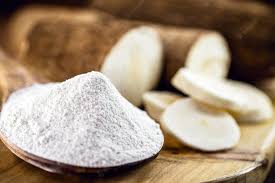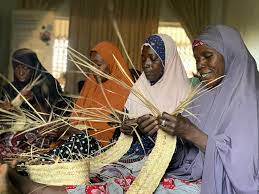
Cassava (Manihotesculenta) production is vital to the economy of Nigeria as the country is the world's largest producer of the commodity. The crop is produced in twenty-four (24) of the country's thirty-six (36) states.
In 1999, Nigeria produced thirty-three million (33,000,000) tons, while a decade later, it produced approximately forty million (40,000,000) tons, which is almost nineteen percent (19%) of production in the world. The average yield per hectare is ten point six (10.6) tonnes.
Currently, the country produces about forty-five million (45,000,000) tons of the cassava tubers annually.
In Nigeria, cassava production is well-developed as an organized agricultural crop. It has well-established multiplication and processing techniques for food products and cattle feed. There are more than forty (40) cassava varieties in use. Cassava is processed in many processing centres and fabricating enterprises set up in the country.
Presently, cassava is primarily produced for food especially in the form of gari, lafun and fufu with little or no use in the agribusiness sector as an industrial raw material. But the crop can be processed into several secondary products of industrial market value.
These products include chips, pellets, flour, adhesives, alcohol, and starch, which are vital raw materials in the livestock, feed, alcohol/ethanol, textile, confectionery, wood, food and soft drinks industries. They are also tradable in the international market.
Cassava is a versatile crop widely grown in Nigeria and is a staple food for millions of people. High quality cassava flour (HQCF) is made by cooking, drying and grinding cassava root to a fine powder. It differs from tapioca flour in that Tapioca flour is made from the starch of the cassava plant where the cassava flour is the ground root. High Quality Cassava Flour (HQCF) is used as substitute for wheat flour in bakery and confectionary products.
The annual national demand for High Quality Cassava Flour (HQCF) is estimated at seven hundred and fifty thousand (750,000) tons while the national supply estimate is about fifty thousand (50,000) tons.
This article aims to provide a comprehensive guide on how to start cassava flour production in Nigeria, covering the key steps, equipment needed, and the potential challenges and opportunities in this venture.
Conducting a Feasibility Study
Before starting any business, it is essential to conduct a feasibility study to assess the viability of the cassava flour production venture. This study should include an analysis of the market demand, competition, availability and cost of raw materials, potential buyers, and the required investment. By conducting thorough research and analysis, you can make informed decisions and develop a solid business plan.
Secure Land and Raw Materials
To establish a cassava flour production facility, you will need to secure suitable land for cultivation and processing. Cassava thrives in tropical and subtropical regions with well-drained soil. Adequate access to water sources is also crucial for irrigation purposes. Acquiring or leasing land that meets these requirements is essential for successful cultivation.
Additionally, you need to ensure a steady supply of high-quality cassava roots. Collaborating with local farmers or establishing your own cassava plantation can help secure a consistent supply of raw materials. Consider selecting cassava varieties that are known for their high starch content, as it directly affects the quality of the flour produced.
Cassava Processing Equipment
To start cassava flour production, you will need specific equipment for various stages of processing. The key machinery includes:
a. Cassava Peeler and Washer: This machine helps remove the outer peels and dirt from cassava roots, ensuring cleanliness and hygiene.
b. Grater: The grater is used to break down the cassava roots into smaller granules or mash. There are various types of graters available, such as manual graters and mechanized grating machines, depending on the scale of production.
c. Hydraulic Press: This equipment is used to extract water from the grated cassava, forming a solid cake or dewatered mash.
d. Flash Dryer: The dewatered cassava mash is dried in a flash dryer to reduce the moisture content. This machine employs hot air circulation to achieve rapid drying.
e. Milling Machine: The dried cassava cake is milled into fine flour using a milling machine. This ensures a consistent particle size and smooth texture.
f. Sieving Machine: A sieving machine is used to remove any impurities or lumps from the cassava flour, resulting in a high-quality end product.
Cassava Flour Processing Steps
The process of cassava flour production involves several key steps:
a. Harvesting and Peeling: Harvest the cassava roots when they have reached maturity, usually 9 to 12 months after planting. Remove the outer peels and wash the roots thoroughly.
b. Grating: Grate the cassava roots using a grating machine to obtain a coarse mash or granules.
c. Dewatering: Squeeze the grated cassava using a hydraulic press to remove excess water and obtain a dewatered mash.
d. Drying: Dry the dewatered cassava mash in a flash dryer until it reaches the desired moisture content, typically around 12%.
e. Milling: Mill the dried cassava cake into fine flour using a milling machine. This step helps achieve a smooth texture and uniform particle size.
f. Sieving: Pass the milled cassava flour through a sieving machine to remove any impurities or lumps, resulting in a high-quality product.
Quality Control and Packaging
Maintaining strict quality control measures is crucial to produce premium cassava flour. Regularly test the flour for moisture content, starch content, and other quality parameters to ensure consistency and meet market standards. Proper packaging is also essential to preserve the flour's freshness and extend its shelf life. Consider using moisture-proof packaging materials and label the packages with relevant information such as production date, batch number, and nutritional content.
Marketing and Distribution
Develop a robust marketing strategy to promote your cassava flour brand and reach potential buyers. Identify target markets, such as bakeries, food processing companies, and consumers interested in gluten-free and alternative flours. Attend trade fairs and food exhibitions to showcase your product and network with potential customers. Establishing partnerships with distributors and wholesalers can help expand your distribution network and reach a wider customer base.
Conclusion
Starting cassava flour production in Nigeria can be a lucrative business opportunity due to the high demand for this versatile product. By conducting a thorough feasibility study, securing suitable land and raw materials, investing in the right equipment, and implementing effective quality control measures, you can establish a successful cassava flour production venture.
With the right marketing strategy and distribution network, you can capitalize on the growing demand for cassava flour and contribute to the agricultural and economic development of Nigeria.






















